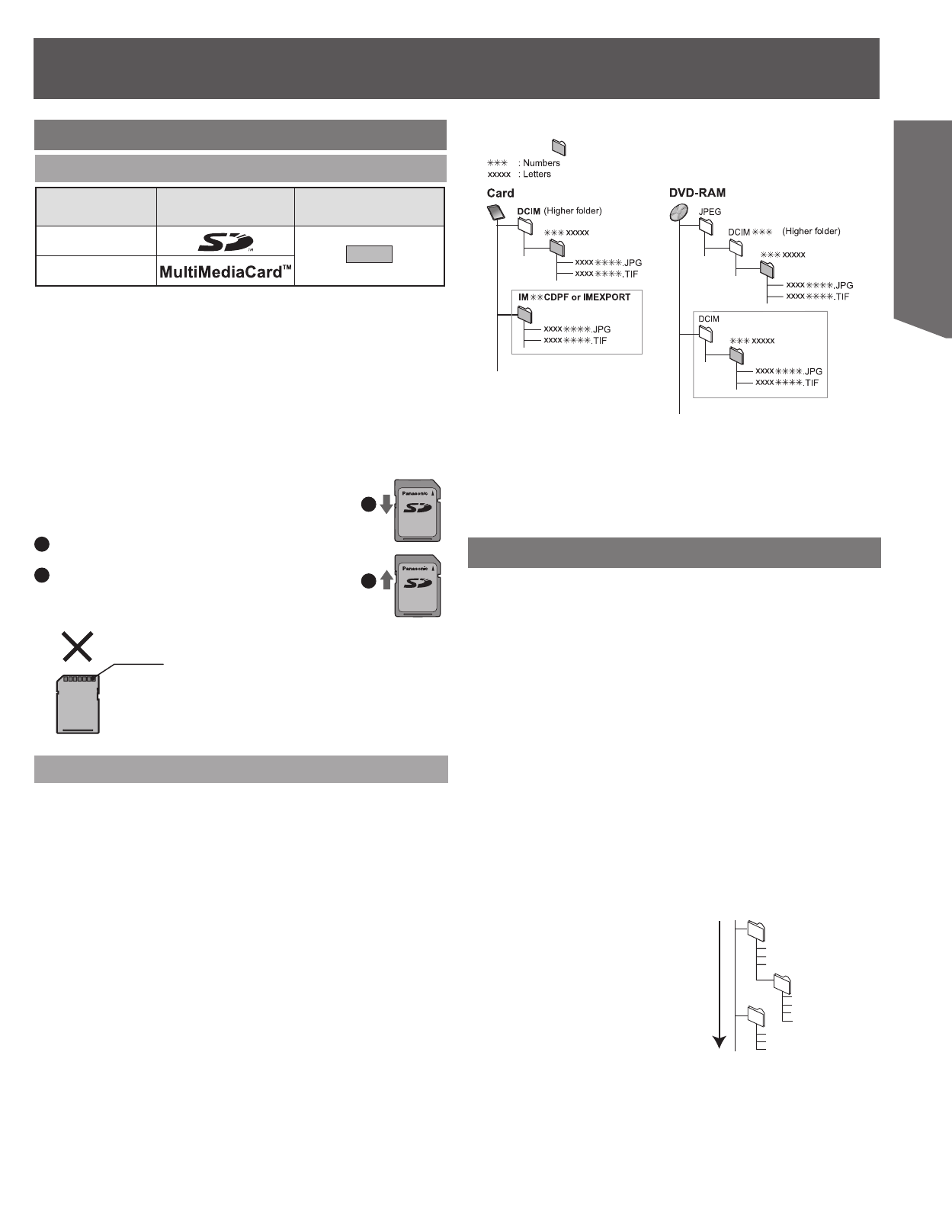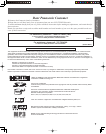
11
Getting Started
• Use a genuine SD Memory Card or MultiMediaCard.
(We recommended using a Panasonic SD card.)
• You cannot use SD cards that exceed 2 GB.
• Compatible with: FAT 12 or FAT 16
• Use this unit to format a memory card when using for the first time (p. 61).
Note that the memory card may no longer be usable on other equipment
once formatted on this unit.
• This unit operates in accordance with the DPOF (Digital Print Order
Format) (p. 56). (Card only)
• Only use the memory cards recommended above.
SD Memory Card Write Protection
You can protect valuable images, etc. from
accidental erasure.
1
Move switch to LOCK : erase/edit not possible.
2
Move switch back : erase/edit possible.
Cards capable of displaying and saving
Card type Card Logo
Indication in these
operating instructions
SD Memory Card
SD
MultiMediaCard
Still Pictures
• The unit can play DCF* compliant JPEG and TIFF files taken on a digital
camera.
* Design rule for Camera File system: unified standard established by Japan
Electronics and Information Technology Industries Association (JEITA).
• Picture definition:
Compatible in the range 34 × 34 – 6 144 × 4 096 (sub sampling is 4:2:2 or
4:2:0)
• This unit can handle a maximum of 300 folders (including header
folders) and 3 000 files. Files and folders with numbers which exceed the
maximum cannot be displayed, copied or erased.
• Audio, video and still pictures (MOTION JPEG etc.) that are not compliant
with the DCF standard and still pictures other than JPEG and TIFF cannot
be displayed.
• Still pictures created or edited on a computer may not be playable.
• TIFF is compatible with uncompressed RGB chunky formats. Other types
of TIFF files cannot be played.
• When playing TIFF files, it may take time for them to be displayed.
• When there are a lot of folders and files, it may take a long time to display,
copy or erase.
• Folder titles that were input on equipment other than this unit may not be
displayed properly.
Still picture folder structure
The following can be displayed on this unit.
*
*
* Folders can be created on other equipment. However, these folders
cannot be selected as a transferring (dubbing) destination.
• The folder cannot be displayed if the numbers are all “0” (e.g., DCIM000
etc).
• If a folder name or filename has been input using other equipment, the
name may not be displayed properly or you may not be able to play or edit
the data.
Card Handling
Do not touch terminal side of card.
1
2
Notes:
• JPEG and TIFF files on a CD-R/CD-RW cannot be played back.
• JPEG and TIFF files on a DVD-RAM can played back.
Naming folders and files
• MP3 files must have the extension
“.MP3” or “.mp3”.
• At the time of recording, give folder
and file names a 3-digit numeric
prefix in the order you want them to
play (this may not work at times).
• English alphabets and Arabic
numerals are displayed correctly.
Other characters may not be
displayed correctly.
Information (MP3)
Tips for making MP3 discs
• Discs must conform to ISO9660 level 1 or 2 (except for extended formats).
• Compatible compression rate:
between 32 kbps and 320 kbps
• Compatible sampling rate:
16 kHz, 22.05 kHz, 24 kHz, 32 kHz, 44.1 kHz and 48 kHz
• Maximum number of tracks and groups recognizable: 999 tracks and
99 groups
• This unit is compatible with multi-session.
• This unit is not compatible with ID3 tags or packet writing.
• Depending on the recording, some items may not be playable.
• Reading or play of the disc may take time if there are a lot of still pictures
or sessions.
• The display order may differ from how the order is displayed on a
computer.
002 group
001
001
001track.mp3
002track.mp3
003track.mp3
003 group
001track.mp3
002track.mp3
003track.mp3
001track.mp3
002track.mp3
003track.mp3
004track.mp3
Root
Order of play
(folder=group)
(file=track)
Note:
• MP3 recordings on a DVD-RAM or DVD-R cannot be played back.
Information (Card)


















